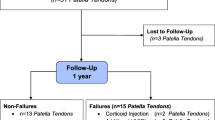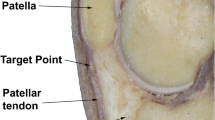Abstract
Purpose
This study aimed to investigate the results of a new treatment procedure (ultrasound-guided injection and the “pie crust” technique for lengthening of capsular tendon structures) for symptomatic bipartite patella.
Methods
We retrospectively investigated patient outcomes following the treatment of symptomatic type III bipartite patella with our new technique. Fifteen knees in 14 boys (mean age, 13.0 ± 1.7 years) were included. The procedure involved the injection of 1% lidocaine (2 mL) and triamcinolone acetonide (5 mg) between the patella and fragment. We then punctured 10 sites from one skin puncture to extend lateral capsular tendon structures. The patients were clinically assessed using the Victorian Institute of Sports Assessment (VISA) score before and 1 week, 1 month, and 3 months after the procedure. Patients were also evaluated for complications.
Results
The average VISA score was 45.7 ± 4.7 before treatment, 70.6 ± 7.3 at 1 week post-treatment, 84.4 ± 16.6 at 1 month post-treatment, and 88.6 ± 18.3 at 3 months post-treatment. The VISA score improvement from before the procedure to 1 week after the procedure was significant (P < 0.01). There were no complications in any of the patients, who returned to sports at a mean of 4.2 ± 2.1 weeks after the procedure. However, two patients (three knees) had poor results and could not return to action; thus, they underwent surgical treatment 4 months after the ultrasonographic procedure.
Conclusions
This novel method is a potential treatment option for the management of symptomatic bipartite patella in outpatient clinics.



Similar content being viewed by others
References
Ogden JA. Radiology of postnatal skeletal development Patella and tibial tuberosity. Skelet Radiol. 1984;11:246–57.
Prakash S, Chopra SRK, Jit I. Ossification of the human patella. J Anat Soc India. 1979;28:78–83.
Canizares GH, Selesnick FH. Bipartite patella fracture. Arthroscopy. 2003;19:215–7.
Saupe E. Beitrag zur patella bipartita. Fortschr Rontgenstr. 1921;28:37–41.
O’Brien J, Murphy C, Halpenny G, et al. Magnetic resonance imaging features of asymptomatic bipartite patella. Eur J Radiol. 2011;78:425–9.
Oohashi Y, Koshino T, Oohashi Y. Clinical features and classification of bipartite or tripartite patella. Knee Surg Sports Traumatol Arthrosc. 2010;18:1465–9.
Gaheer RS, Kapoor S, Rysavy M. Contemporary management of symptomatic bipartite patella. Orthopedics. 2009. https://doi.org/10.3928/01477447-20090922-20.
Mori Y, Okumo H, Iketani H, et al. Efficacy of lateral retinacular release for painful bipartite patella. Am J Sports Med. 1995;23:13–8.
Adachi N, Ochi M, Yamaguchi H, et al. Vastus lateralis release for painful bipartite patella. Arthroscopy. 2002;18:404–11.
McMahon SE, LeRoux JA, Smith TO, et al. The management of the painful bipartite patella: a systematic review. Knee Surg Sports Traumatol Arthrosc. 2016;24:2798–805.
Matic GT, Flanigan DC. Return to activity among athletes with symptomatic bipartite patella: a systematic review. Knee. 2015;22:280–5.
Visentini PJ, Khan KM, Cook JL, et al. The VISA score: an index of severity of symptoms in patients with jumper’s knee (patellar tendinosis). Victorian Institute of Sport Tendon Study Group. J Sci Med Sport. 1998;1:22–8.
Atesok K, Doral MN, Lowe J, et al. Symptomatic bipartite patella: treatment alternatives. J Am Acad Orthop Surg. 2008;16:455–61.
Feil L, Formica M, Lovisolo S, et al. Clinical outcome of arthroscopic lateral retinacular release for symptomatic bipartite patella in athletes. Arthroscopy. 2018;34:1550–8.
Wong CK. Bipartite patella in a young athlete. J Orthop Sports Phys Ther. 2009;39:560.
Ishikawa H, Sakurai A, Hirata S, et al. Painful bipartite patella in young athletes. The diagnostic value of skyline views taken in squatting position and the results of surgical excision. Clin Orthop Relat Res. 1994;305:223–8.
Ogata K. Painful bipartite patella: a new approach to operative treatment. J Bone Joint Surg Am. 1994;76:573–8.
Green WT Jr. Painful bipartite patellae: a report of three cases. Clin Orthop. 1975;110:197–200.
Clarke HD, Fuchs R, Scuderi GR, et al. Clinical results in valgus total knee arthroplasty with the “pie crust” technique of lateral soft tissue releases. J Arthroplasty. 2005;20:1010–4.
Claret G, Montañana J, Rios J, et al. The effect of percutaneous release of the medial collateral ligament in arthroscopic medial meniscectomy on functional outcome. Knee. 2016;23:251–5.
Author information
Authors and Affiliations
Corresponding author
Ethics declarations
Conflict of interest
The authors have no conflicts of interest to declare.
Ethical statement
Ethical approval for the present study was obtained from our institutional review board. Patients were informed of the study aims and procedures, and they provided written informed consent along with their parents.
Informed consent
Patients were informed of the study aims, procedures, and publication, and they provided written informed consent along with their parents.
Additional information
Publisher's Note
Springer Nature remains neutral with regard to jurisdictional claims in published maps and institutional affiliations.
About this article
Cite this article
Nakase, J., Oshima, T., Takata, Y. et al. Ultrasound-guided injection and the pie crust technique for the treatment of symptomatic bipartite patella. J Med Ultrasonics 46, 497–502 (2019). https://doi.org/10.1007/s10396-019-00960-4
Received:
Accepted:
Published:
Issue Date:
DOI: https://doi.org/10.1007/s10396-019-00960-4




